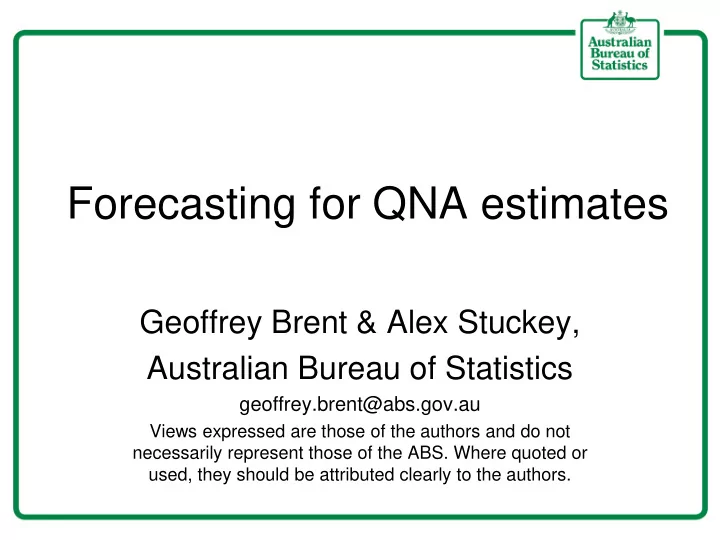

Forecasting for QNA estimates Geoffrey Brent & Alex Stuckey, Australian Bureau of Statistics geoffrey.brent@abs.gov.au Views expressed are those of the authors and do not necessarily represent those of the ABS. Where quoted or used, they should be attributed clearly to the authors.
Background Want to produce a timely, accurate series of Quarterly National Accounts, based on 2 inputs: • Annual “benchmark” series – Accurate but not quarterly, not timely (~2 yrs lag) • Quarterly “indicator” series – Timely but less accurate
Back series For older years where benchmark data is available, use indicator series to pro-rate BM between quarters • Aim to preserve quarter-to-quarter movements from indicator series as much as possible • Several different methods available: e.g. Denton-Cholette, Cholette-Dagum, Chow-Lin, Enhanced Denton (Di Fonzo-Marini), Litterman, Fernandez
Forward series For recent years w/ benchmark not yet available, use indicator to estimate QNAs • Estimates are based on observed relationships between benchmark and indicator – e.g. B/I ratio from last benchmarked quarter • Typically estimated within benchmarking method, but can fit separately
Revisions • Estimates revised each year as new benchmark data arrives • B/I relationship may change gradually or abruptly • If forward-series estimation doesn’t get BI relationship right, bias and/or large revisions could result
Forecast methods • Previous work by Y. Poorun, R. Mathews, J. Chien, P. Gould suggested forecasting BI ratios separately might improve quality of forward estimates • We used R to test a range of benchmarking and forecast methods on ABS series (13 Industry, 44 Public Capital) • FC methods included random walk, random walk with drift, exponential smoothing, ARIMA • Evaluated results on bias (initial relative to final estimates) and magnitude/timeliness of revisions
Example forecast methods
Results: Industry • Average across 13 series shown • Denton/Cholette/ Dagum methods do well on revisions • RWD reduces bias noticeably, small increase in revs • No outliers
Results: Public Capital • Average outcomes for 44 series • Similar to Industry: D/C/D best on revisions, RWD minimises bias • Chow-Lin revisions affected by outliers (~+0.2 to average)
Summary • Explicitly forecasting BI ratios can reduce bias (especially RWD method) • Complex forecasting methods e.g. ETS, Holt, ARIMA didn’t perform as well as RWD (possibly due to short data-fitting period?) • RWD slightly increases revisions – but may be worthwhile for bias reduction?
Recommend
More recommend